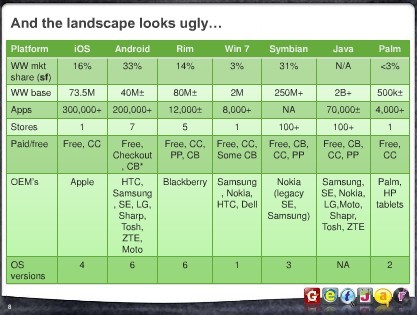GetJar首席营销官评手机应用与移动网页发展前景
在日前的SXSW大会上,独立应用商店GetJar首席营销官帕特里克·莫克(Patrick Mork)的演讲主题是“手机应用 vs. 移动网页”,他通过一组幻灯片资料指出,Android已经成为掌握美国最大市场份额的手机平台,去年全球手机应用下载量已超过80亿次,预计2012年将达500亿次,2015年手机应用总营收将达300亿美元;苹果、Android和GetJar三大平台共有60多万个应用程序。
手机应用与移动网页的对比优势
莫克认为,手机应用总能提供比网页更具黏性的用户体验(不过HTML5技术有可能改变这种局面),它们可以充分发挥移动硬件设备的功能优势(例如触摸屏、加速计等),当然在设计上也更具吸引力。
但移动网页也有自身优势,在可覆盖的用户范围上更是如此。游戏邦获悉,目前世界上有1.4亿部移动设备可运行手机应用,但可上网的移动设备却超过了10亿部。另外,网页应用的开发成本更低,更容易传播和即时更新。缺点就是它们通常需要连网才能提供服务,但HTML5提供的离线缓冲功能除外。
手机应用开发商的发展思路
在莫克看来,在开发手机应用时,开发商首先要理清几个问题:什么是用户安装基础?手机原始设备制造商对这个平台的用途是什么?是否提供计费系统?市场上共有多少个分销渠道(即多少家应用商店)?这种类型的应用数量有多少?这个手机平台有多少个版本(手机平台分散性的问题)?
莫克的幻灯片共有16页,以下是游戏邦编译GetJar关于手机平台发展格局的相关资料:
在iOS、Android、RIM、Win7、Symbian、Java和Palm这几大主流手机操作系统中,iOS的市场份额为16%;Andorid独占33%,Symbian也仍然还有31%的比例,Palm还不足3%;
iOS手机应用共30多万种,Android应用数量也超过了20万,RIM则仅1.2万左右;
iOS的应用商店仅App Store一家,而Android却多达7家,RIM也有5家,Win7和Palm均仅一家,Symbian和Java分别都超过了100家。
从各个平台的原始移动设备制造商数量来看,苹果是iOS唯一的原始设备制造商,Android的硬件设备制造商则包括HTC、三星、LG等多家厂商,RIM仅黑莓一家设备制造商,Win7的手机制造商包括三星、诺基亚和HTC、戴尔。
iOS共发布了4个版本,Android和RIM都有6个版本,Win7仅有一个,Symbian有3个版本,Palm有2个版本。(本文为游戏邦/gamerboom.com编译,转载请注明来源:游戏邦)
SXSW: Examining the Mobile App Landscape with GetJar’s Patrick Mork
“Android is now the leading smartphone in market share in the United States,” noted GetJar’s Patrick Mork, beginning today’s session at SXSW on the topic of apps vs. the mobile Web. Mork provided other interesting stats about the state of the mobile application industry during this afternoon’s talk, including figures like this: there were over 8 billion downloads last year, there will be an estimated 50 billion downloads by 2012 and an estimated $30 billion in revenue by 2015. And there are over 600,000 apps between Apple, Android and GetJar, the large third-party mobile application store where Mork serves as Chief Marketing Officer.
The keynote speech was limited to only 15 minutes, unfortunately, as this is a topic that could be explored for hours. However, Mork made good use of the time, and presented some great slides which mobile developers may find useful. These are embedded below.
Benefits of Apps vs. Web
Speaking about the benefit of mobile apps, Mork said they are always “on,” offer deeper engagement than what you get on the Web (although HTML5 is beginning to change this), they can leverage device power features (touchscreen, accelerometer), and, of course, they’re viral and “sexy.”
But the Web also has advantages too, mainly: reach. There are 140 million devices that run apps, but over a billion that can access the Web. Web apps are also cheaper to develop, easier to distribute and offer instant updates. But the downside is that Web apps generally require connectivity to work, except in the case of the offline caching provided by HTML5.
Strategy Questions for Mobile Developers
When developing for mobile, there are several questions related to strategy that a developer needs to ask, said Mork, like: what is installed base, what OEMs are using this platform, is billing available, what’s the ease of distribution (how many app stores are there), how big is the catalog and how many versions of the OS are out there (i.e., fragmentation issues)?
Mork then touched on a few sample cases studies regarding how large companies promote their mobile applications, including Facebook, Fandango and Yahoo.
The slides from Mork’s presentation are below – note especially the 8th slide, which has some great stats regarding the current mobile app landscape, including number of apps, number of stores and number of OS versions.(source:readwriteweb)










































